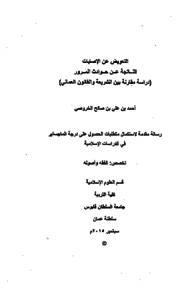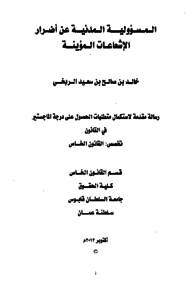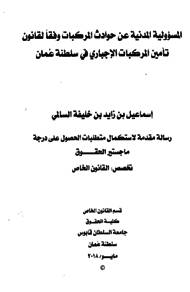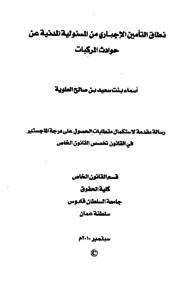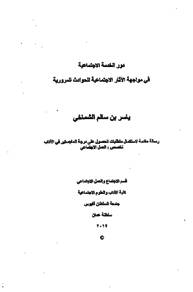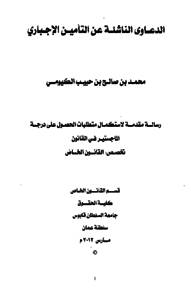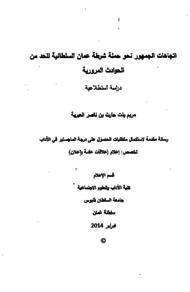Document
التعويض عن الإصابات الناتجة عن حوادث المرور : دراسة مقارنة بين الشريعة و القانون العماني.
Publisher
جامعة السلطان قابوس
Gregorian
2015
Language
Arabic
English abstract
Traffic accidents are contemporary events that result in numerous damages including the loss of human life. The continuous increase in these accidents has caught my interest in the topic and motivated me to study it from an Islamic legal (fiqhi) and judicial perspective.
This study aims at lifting the veil from the aspect of compensation following the damages induced by car accidents.
The thesis consists of an introduction, then an introductory chapter followed by two study chapters and a conclusion.
The introduction explains the problem and importance of the study, the reasons for my choice of this topic, previous studies on the problem, as well as the study's methodology and plan.
The introductory chapter clarifies the intended meanings, such as "road" and "traffic accident" in Islamic law (fiqh) and jurisprudence. It further establishes the Islamic legal foundation of the topic of road accidents, thereby arriving at the legitimacy of compensation (ta'widh) and liability (tadhmin) for injuries resulting from road accidents under allusion to the Islamic legal evidences.
The first chapter states the different types of damages arising from traffic accidents, explaining the concept of damage from the Islamic legal (fiqhi) as well as judicial perspective under comparison between both. It then arrives at the definition of damage (dharar) as "harm inflicted on any other party absolutely".
This chapter mentions the different types of damage and the guidelines to their consideration in Islamic law and the different types of damage and the conditions for their compensation in judicial thought. It became clear to me that damage is divided into material and non-material damage. The first designates damage incurred to the body or wealth, the second designates damage incurred to interests other than wealth. The later is referred to as non-material damage ("dharar adabi", "dharar ma'nawi").
The second chapter treats the case of financial guarantee or compensation in terms of explaining the concept first linguistically, then from the perspective of Islamic law and judicially. It then goes on to explain physical injuries and the amounts of compensation in Islamic law as compared to the legal texts. These are referred to with the technical term "al-Uroosh" in Islamic law, meaning the stipulated financial amounts liable to be paid for damages that are not specified. Their specification is then carried out by the "Government of Justice" (hukumat al-"adl). It became clear to me that the specific amount of the diyah (blood money) in Islamic law has been assessed by the Lawgiver starting from a toe nail to scalp hair, ranging from slapping to homicide, where the full diyah is to be paid for homicide and what comes under the same rule in meanings and senses. The full diyah is also liable for injuries of organs present in pairs if this is vital for their usage, or the completeness of beauty, as well as what comes in quadruples such as the edges of the eye lids, and what is present in tens, such as the fingers of the hands, and injuries and different organs of the body.
The "Arsh" is compulsory for fractures and injuries whose compensation have been specified by the Lawgiver. As to those which have not been specified by the Lawgiver, these are to be specified by the "Government of Justice".
The second chapter also mentions the general foundations of compensation in the Law and their judicial application in cases of compensation; in as far as the guidelines specified by the Law for assessing compensation have been arrived at. In the following, the chapter explains judicial applications in cases of compensation in traffic accidents in the Sultanate of Oman.
At the end of chapter two, the permissibility of compensation for non-material damage is explained. It is clarified that the technical term "non-material damage" is an innovation, with divergent contemporary fiqhi views between the permissibility and non-permissibility of material compensation. Judicial thought treats this issue in outspoken texts in civil law determining the permissibility of financial compensation for non-material damage.
The conclusion states the most important results and conclusions the researcher arrived at in his thesis. Our last supplication is that Al Praise is due to Allah, the Lord of the
Worlds.
Member of
Resource URL
Arabic abstract
حوادث المرور نازلة من نوازل العصر، وتنتج عنها أضرار متعددة تطال النفس البشرية، وإن التزايد المطرد في هذه الحوادث هو ما دعاني إلى الاهتمام بهذا الموضوع من أجل دراسته دراسة فقهية وقانونية.
ولذا جاءت هذه الدراسة المتواضعة لتكشف اللثام عن الجانب التعويضي المترتب على الأضرار الناجمة من حوادث السيارات. وتقع الرسالة في مقدمة ثم فصل تمهيدي يتبعه ثلاثة فصول ثم خاتمة.
أشرت في المقدمة إلى مشكلة الدراسة وأهميتها، وأسباب اختياري، والدراسات السابقة في الموضوع، ومنهج البحث وخطته.
أوضح الباحث في الفصل التمهيدي المعاني المقصودة بالطريق والحادث المروري في الفقه الإسلامي والقانون، ثم تطرق لبيان التأصيل الشرعي لحوادث المرور، حيث خلص إلى مشروعية التعويض والتضمين في الإصابات الناتجة عن الحوادث المرورية، استنادا إلى الأدلة الشرعية وفي الفصل الأول عرج الباحث لبيان أنواع الأضرار الناتجة عن حوادث السير، موضحة مفهوم الضرر من الناحيتين الشرعية والقانونية، مع المقارنة بينهما، وتم اختيار تعريف الضرر بأنه: " إلحاق مفسدة بالغير مطلق".
وتخلل هذا الفصل ذکر أنواع الأضرار وضوابط اعتبارها في الفقه الإسلامي، وأنواع الضرر وشروط تعويضها في الفكر القانوني، واتضح لي أن الضرر ينقسم إلى ضرر مادي، وضرر غير مادي، فالأول يراد به الضرر الواقع على الجسد أو المال، والنوع الثاني يقصد به الضرر الواقع على مصلحة غير مالية، وهو المعبر عنه بالضرر الأدبي أو المعنوي وجاء الفصل الثاني من الرسالة ليعالج قضية الضمان المالي أو التعويض من حيث بيان مفهومه لغة وشرعا وقانونأ، ليصل بنا المطاف - في الفصل الثالث - البيان الإصابات البدنية ومقادير تعويضها في الفقه الإسلامي مقارنا بالنصوص القانونية، والمعبر عنها بمصطلح "الأروش" في الفقه الإسلامي، ويقصد بها المقادير المالية المحددة شرعا والواجبة في الإصابات الواقعة على ما دون النفس من الجراح والكسور وغيرها، وأما الإصابات غير المقدرة فيتم تقديرها عن طريق ما يسمى ب" حكومة العدل"، وقد تبين لي أن مقدار الدية في الفقه الإسلامي محدد من قبل الشارع ابتداء من ظفر الرجل إلى شعر الرأس ، ومن اللطمة إلى قتل النفس ، حيث تجب دية كاملة في قتل النفس ، وما في حكمها من المعاني والحواس ، ثم تجب الدية الكاملة في اثنين من الجوارح فيهما جنس منفعة أو جمال على الكمال، وهكذا في كل رباعي كأشفار العينين ، وعشاري كأصابع اليدين من الأطراف والجوارح وأعضاء الجسم المختلفة.
ثم يجب الأزش في الشجاج والجروح التي قتر المقابل لها من قبل الشارع، أما الشجاج والجروح التي ليس لها مقدار معلوم من قبل الشارع فيتم تقديرها بحكومة العدل .
كما تم التطرق في الفصل الثالث لذكر الأسس العامة للتعويض في القانون والتطبيق القضائي في قضايا التعويض، حيث تم إيراد المعايير التي حددها القانون عند تقدير التعويض، ثم تبع ذلك بيان التطبيقات القضائية في قضايا التعويض في حوادث المرور بسلطنة عمان.
وفي نهاية الفصل الثالث، جاء الحديث عن مدى جواز التعويض عن الضرر المعنوي، حيث اتضح أن مصطلح " الضرر المعنوي" هو مصطلح حادث، وقد تباينت حوله النظرة الفقهية المعاصرة بين من يرى جواز التعويض عنه بالمال، وبين من يتجه إلى عدم مشروعية التعويض عنه، في حين حسم الفكر القانوني هذه المسألة بنصوص صريحة في القوانين المدنية التي نصت على جواز التعويض بالمال عن الضرر المعنوي.
وجاءت الخاتمة لتوضح أهم النتائج والخلاصة التي وصل إليها الباحث في رسالته.
ولذا جاءت هذه الدراسة المتواضعة لتكشف اللثام عن الجانب التعويضي المترتب على الأضرار الناجمة من حوادث السيارات. وتقع الرسالة في مقدمة ثم فصل تمهيدي يتبعه ثلاثة فصول ثم خاتمة.
أشرت في المقدمة إلى مشكلة الدراسة وأهميتها، وأسباب اختياري، والدراسات السابقة في الموضوع، ومنهج البحث وخطته.
أوضح الباحث في الفصل التمهيدي المعاني المقصودة بالطريق والحادث المروري في الفقه الإسلامي والقانون، ثم تطرق لبيان التأصيل الشرعي لحوادث المرور، حيث خلص إلى مشروعية التعويض والتضمين في الإصابات الناتجة عن الحوادث المرورية، استنادا إلى الأدلة الشرعية وفي الفصل الأول عرج الباحث لبيان أنواع الأضرار الناتجة عن حوادث السير، موضحة مفهوم الضرر من الناحيتين الشرعية والقانونية، مع المقارنة بينهما، وتم اختيار تعريف الضرر بأنه: " إلحاق مفسدة بالغير مطلق".
وتخلل هذا الفصل ذکر أنواع الأضرار وضوابط اعتبارها في الفقه الإسلامي، وأنواع الضرر وشروط تعويضها في الفكر القانوني، واتضح لي أن الضرر ينقسم إلى ضرر مادي، وضرر غير مادي، فالأول يراد به الضرر الواقع على الجسد أو المال، والنوع الثاني يقصد به الضرر الواقع على مصلحة غير مالية، وهو المعبر عنه بالضرر الأدبي أو المعنوي وجاء الفصل الثاني من الرسالة ليعالج قضية الضمان المالي أو التعويض من حيث بيان مفهومه لغة وشرعا وقانونأ، ليصل بنا المطاف - في الفصل الثالث - البيان الإصابات البدنية ومقادير تعويضها في الفقه الإسلامي مقارنا بالنصوص القانونية، والمعبر عنها بمصطلح "الأروش" في الفقه الإسلامي، ويقصد بها المقادير المالية المحددة شرعا والواجبة في الإصابات الواقعة على ما دون النفس من الجراح والكسور وغيرها، وأما الإصابات غير المقدرة فيتم تقديرها عن طريق ما يسمى ب" حكومة العدل"، وقد تبين لي أن مقدار الدية في الفقه الإسلامي محدد من قبل الشارع ابتداء من ظفر الرجل إلى شعر الرأس ، ومن اللطمة إلى قتل النفس ، حيث تجب دية كاملة في قتل النفس ، وما في حكمها من المعاني والحواس ، ثم تجب الدية الكاملة في اثنين من الجوارح فيهما جنس منفعة أو جمال على الكمال، وهكذا في كل رباعي كأشفار العينين ، وعشاري كأصابع اليدين من الأطراف والجوارح وأعضاء الجسم المختلفة.
ثم يجب الأزش في الشجاج والجروح التي قتر المقابل لها من قبل الشارع، أما الشجاج والجروح التي ليس لها مقدار معلوم من قبل الشارع فيتم تقديرها بحكومة العدل .
كما تم التطرق في الفصل الثالث لذكر الأسس العامة للتعويض في القانون والتطبيق القضائي في قضايا التعويض، حيث تم إيراد المعايير التي حددها القانون عند تقدير التعويض، ثم تبع ذلك بيان التطبيقات القضائية في قضايا التعويض في حوادث المرور بسلطنة عمان.
وفي نهاية الفصل الثالث، جاء الحديث عن مدى جواز التعويض عن الضرر المعنوي، حيث اتضح أن مصطلح " الضرر المعنوي" هو مصطلح حادث، وقد تباينت حوله النظرة الفقهية المعاصرة بين من يرى جواز التعويض عنه بالمال، وبين من يتجه إلى عدم مشروعية التعويض عنه، في حين حسم الفكر القانوني هذه المسألة بنصوص صريحة في القوانين المدنية التي نصت على جواز التعويض بالمال عن الضرر المعنوي.
وجاءت الخاتمة لتوضح أهم النتائج والخلاصة التي وصل إليها الباحث في رسالته.
Category
Theses and Dissertations

